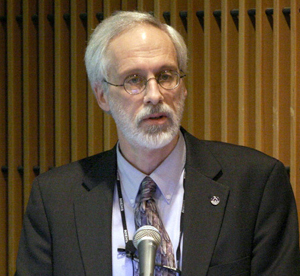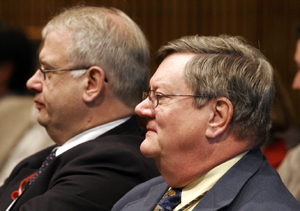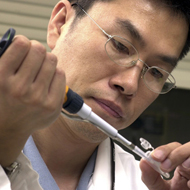
Environmental Factor, January 2008, National Institute of Environmental Health Sciences
Bucher Announces NTP Realignment
By Eddy Ball
January 2008


During his report to the National Toxicology Program (NTP) Board of Scientific Counselors on December 6 (see related Spotlight story), NTP Associate Director John Bucher, Ph.D., presented an update on the realignment of the program within the NIEHS Division of Intramural Research. These changes are being implemented in order to give a clearer identity to the activities, staff and resources associated with the NTP.
According to Bucher, “This realignment provides greater transparency to the NTP budget as well as clarifies our physical location, capabilities and mission. Our traditional testing and assessment activities are strong, but now we have an organizational scaffold to accelerate fulfillment of our goals in the NTP Roadmap and building new programs.”
The realignment was completed on October 28, 2007, with staff assignments to a newly designated program office and five branches. New appointments included Deputy Program Director for Policy Mary Wolfe, Ph.D., and Deputy Program Director for Science Nigel Walker, Ph.D.
• Program Office is comprised of the Office of Liaison, Policy and Review, also headed by Wolfe; Office of Nomination and Selection, directed by Scott Masten, Ph.D.; Report on Carcinogens, under Bill Jameson, Ph.D.; the NTP Interagency Center for the Evaluation of Alternative Toxicological Methods (NICEATM), headed by Bill Stokes, D.V.M.; and the Center for the Evaluation of Risks to Human Reproduction (CERHR), under Mike Shelby, Ph.D.
• Toxicology Branch, headed by Acting Chief Paul Foster, Ph.D., brings together all of the toxicology efforts within NTP, with a renewed emphasis on integrating toxicology studies with toxicokinetics and toxicogenomics. Significant activities include directing interagency agreements with the Food and Drug Administration’s National Center for Toxicological Research and the Center for Disease Control and Prevention’s National Institute for Occupational Safety and Health.
• Cellular and Molecular Pathology Branch, headed by Robert Sills, D.V.M., Ph.D., provides support for NTP pathology and program archives and support for pathology investigations by intramural researchers. One of this group’s many current projects is compiling an atlas of non-neoplastic lesions in rodents.
• Program Operations Branch, headed by Acting Chief Cynthia Smith, Ph.D., provides oversight for activities that support NTP research and testing, including chemistry activities, studies related to absorption, distribution, metabolism, and excretion (ADME), quality assurance, maintenance and development of data capture and retrieval systems, the central data repository, and the NTP web site.
• Host Susceptibility Branch, headed by Acting Chief Jef French, Ph.D., is responsible for planning, conducting and analyzing assessments of chemical toxicity in multiple murine strains. Another function of this group is putting together collaborations that will foster an interaction among the NTP, intramural and extramural investigators, and potential public-private partnerships to examine the genetic basis of response to environmental exposures and the clinical manifestations of resulting disease states.
• Bio-molecular Screening Branch, headed by Acting Chief Ray Tice, Ph.D., is charged with implementing the portion of the NTP Roadmap related to development of high- and medium-throughput screening activities. This branch works cooperatively with the Environmental Protection Agency’s ToxCast program and the NIH Chemical Genomics Center to identify and evaluate in vitro and cell based high-throughput assays as tools useful for screening and prioritizing chemicals for toxicity testing. This branch also carries out NTP automated screening of C. elegans performed at NIEHS by the WormTox Group headed by Jonathan Freedman, Ph.D.
"Environmental Justice..." - previous story ![]()
![]() next story - "NIEHS Kicks Off..."
next story - "NIEHS Kicks Off..."
January 2008 Cover Page



